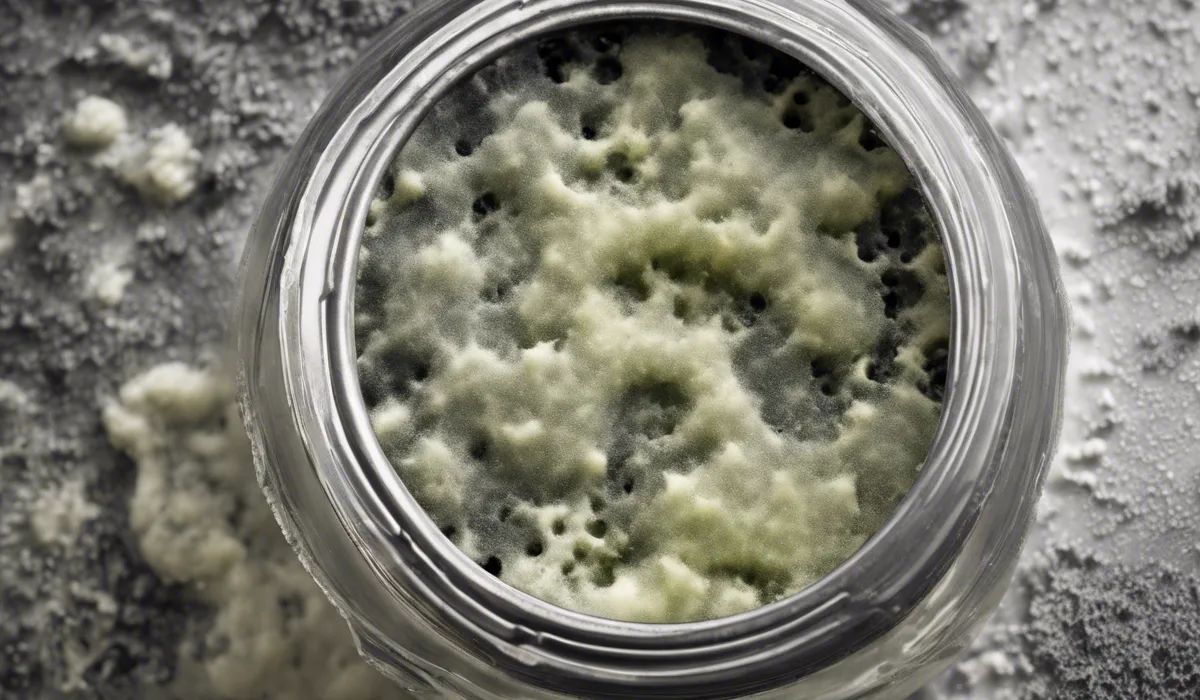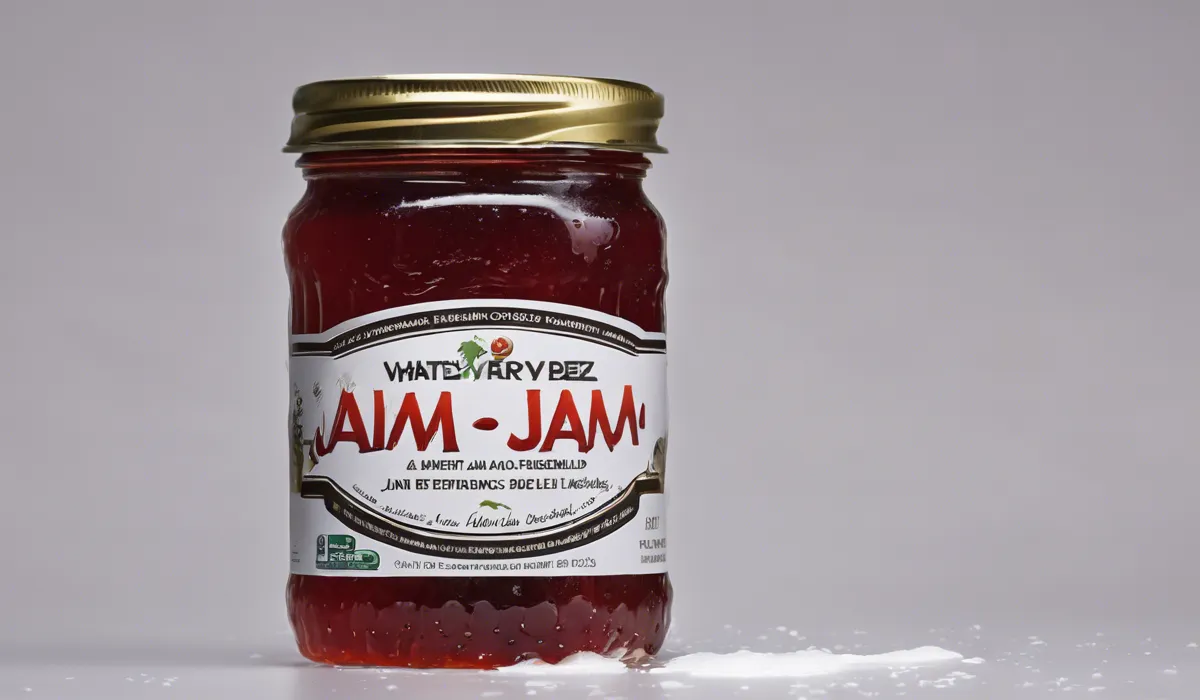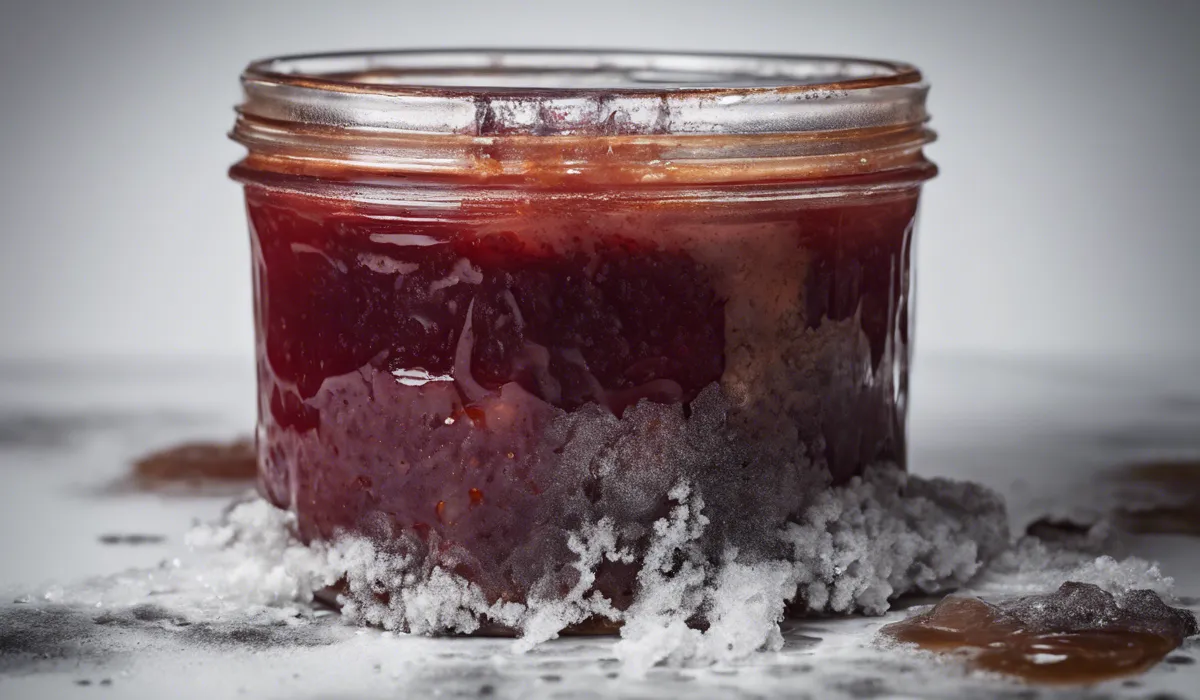Mold on jam typically appears as fuzzy spots that can be green, black, or white. It often starts as small dots and grows to cover the surface. The mold may also have a yeasty smell and cause the jam to have a slimy texture.
Recognizing Mold on Jam

Identifying Mold by Color
Mold on jam can present itself in various hues, making it relatively easy to spot. White mold is often the first sign of fungal growth and may look innocent, but it’s a clear indicator that the jam is no longer safe to eat.
Green and blue molds are familiar sights on bread but can also find their way into your jam jar, often signaling deeper contamination. Black mold is particularly concerning due to its potential to produce harmful toxins.
Occasionally, you might even see spots of pink mold, which are less common but no less risky. No matter the color, any sign of mold means the jam should not be consumed.
The Texture of Mold
While mold’s color is a helpful identifier, its texture also provides significant clues. Mold tends to have a fuzzy or cotton-like appearance, which is a stark contrast to the smooth texture of fresh jam.
If you notice your jam has a dull, fluffy layer on top or within, it’s best to assume mold has taken hold. These mold spores can quickly spread, creating clusters or spots that ruin the jam’s consistency and make it unsafe for consumption.
Spotting Mold Growth
Mold typically begins as small dots that can be overlooked if you’re not cautious. Over time, these dots expand into larger clusters that cover the surface of the jam, especially in areas exposed to air.
Mold may also cause the jam to develop an off-putting yeasty smell and a slimy texture that deviates from the jam’s original quality. Always inspect the surface before use to ensure no mold has formed.
Crystallized Sugar vs. Mold
Not every change in your jam’s appearance is a cause for concern. Crystallized sugar can sometimes be mistaken for mold due to its white color.
However, sugar crystals are shiny and gritty, and they typically form at the bottom or sides of the jar rather than on the surface.
Mold, on the other hand, has a dull and fluffy texture and tends to grow on the surface where the jam has been exposed to air. If you’re unsure, it’s safer to err on the side of caution and avoid eating the jam.
Health Implications of Consuming Moldy Jam

Risks of Ingesting Mold
Eating moldy jam is not just unpleasant; it can be harmful to your health. Mold can cause allergic reactions in some individuals, leading to sneezing, coughing, or even more severe respiratory issues.
Moreover, certain molds produce mycotoxins, which are toxic substances that can lead to a variety of health problems. It is crucial to understand these risks and to avoid consuming moldy food products.
The Dangers of Mycotoxins
Mycotoxins are chemicals produced by certain types of mold that can have serious effects on health.
These toxins can contaminate food and lead to symptoms like nausea, vomiting, and even long-term liver damage.
The presence of mycotoxins makes it even more imperative to discard any jam with visible mold, as it’s not possible to determine just how deep the contamination goes or if dangerous toxins are present.
Understanding Mold Varieties
Not all molds are created equal. Some, like Penicillium, can be benign in one form yet hazardous in another.
Black mold, known as Stachybotrys, is particularly notorious for its health implications. It’s essential to recognize that any mold, regardless of type, signifies a compromised product and should be treated with caution.
The Need to Discard Moldy Foods
When it comes to moldy jam, the safest course of action is to throw it away. Mold can penetrate deeper than the visible surface, contaminating the entire product.
Consuming even a small amount of moldy food can lead to health issues, so it’s best to eliminate the risk entirely by discarding any affected jars of jam.
Preventing Mold Growth on Jam

Proper Storage Solutions
One of the most effective ways to prevent mold growth is through proper storage. Keeping your jam refrigerated is crucial, as the cool temperature slows the growth of mold spores.
Additionally, using airtight containers helps to keep out air, which can carry mold spores and other contaminants. Ensuring your jam is properly sealed after each use can significantly extend its shelf life.
Using Clean Utensils
Cross-contamination is a common cause of mold growth in jams. Always use clean utensils when serving jam to prevent introducing mold spores or bacteria from other foods.
This practice helps maintain the purity of the jam and reduces the risk of mold formation.
Responding to Mold Discovery
If you find mold in your jam, the best action is to discard the entire contents of the jar. Mold roots can infiltrate deep into the jam, beyond what is visible to the naked eye.
For safety, it’s also important to clean any spoons or knives that may have come in contact with the moldy jam, as well as the area where the jar was stored, to prevent spreading spores to other foods or surfaces.
Jam-Making Best Practices
When making homemade jam, following best practices can help prevent mold from forming in the first place.
Sterilizing jars and equipment before use is essential to kill any existing mold spores.
Additionally, using the correct sugar to fruit ratios and maintaining proper acidity levels can inhibit mold growth.
Sugar acts as a natural preservative, and high acidity levels create an environment where mold struggles to thrive. Together, these practices help to ensure your jam stays fresh and mold-free for longer.
FAQs About Mold on Jam
What are the initial signs of mold on jam?
The initial signs of mold on jam include small dots that may be green, black, or white.
How can I identify mold growth on jam?
Mold growth on jam is identifiable by fuzzy spots that grow to cover the surface and may change the texture to slimy.
What colors indicate mold presence on jam?
Mold on jam can be green, black, or white, indicating its presence.
Does mold on jam have a distinct smell?
Yes, mold on jam may have a yeasty smell, which is a sign of spoilage.
What happens to the texture of jam when it is moldy?
When jam is moldy, it can have a slimy texture.
Final Thoughts
Mold on jam is recognizable by fuzzy spots in green, black, or white hues. These spots typically emerge as small dots and can expand to cover the jam’s surface.
Alongside visual changes, mold can impart a yeasty odor and alter the jam’s texture, making it slimy.
